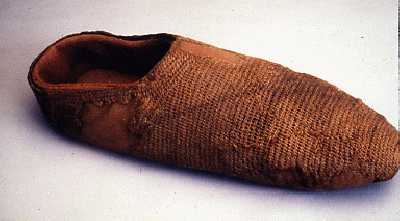Summary: Inspired by the Coppergate sock, I set out to create a pair of nalbound socks of my own. Having practiced the techniques using the Oslo stitch on a hat, a pair of mittens, and a pouch, I felt I could move on to socks. They are cozy, warm and very useful for a lady of the Danelaw. The choice of red for the contrasting color for the edge is in keeping with a predominance of red found in Jorvik digs for textiles such as the original sock. They are currently a bit too large for my feet, but they will full down to a smaller size with wear and washing. They have not been pre-washed and worn so that the stitches will be more visible. I have heard that 15% shrinkage is common and should be expected.
|
Extant Example: A 10th century woolen sock of nalbinding has been discovered in the York Archaeology digs at Coppergate. This is often referred to as the Coppergate Sock. A stitch has been identified as the York Stitch, UU/OOO, based on the finding of this sock and that it is like no other in composition. After learning some of the other stitch types from Schmitt, I found the York stitch to be primitive in construction and difficult to manage at the same time. The weight of the yarn in use seems to be less than the bulky Lopi yarn I am accustomed to working with, giving the Coppergate sock a finer gauge than I could achieve. The pictures given of the surviving sock do not show many details of the heel, but you can see the beginning of the heel where the stitches seem to split in their spiral to leave room for an after-thought heel.
Another interpretation of the sock has a slit at the top of the foot, more like Schmitt's "Banana Sock", but I cannot conclusively see that in the pictures given. They also believe that the heel was more complicated in construction of having the rows zig zag and turn around on themselves instead of spiraling inwards like an after-thought heel. Without a closer look at either more images or the sock itself (I can dream), I cannot say that my interpretation is the correct one, just one that seemed to work.
The Coppergate sock was primarily made out of an undyed natural wool yarn, dye test on the body of the sock were negative. However traces of madder dye chemicals have been found in the last row on the edge of the ankle cuff for decoration.
Materials and Process: I started with two skeins of brown Lopi bulky yarn, and some red for decoration. This is thicker yarn than in the original, but it is a weight I am comfortable working with. Having had difficulty in felting the ends with a lighter weight yarn, I thought the Lopi was best. After discovering that the York stitch was a bit unmanageable, I decided to use the Oslo stitch (Hald Type IIa, UO/UOO) since I was comfortable with that technique and it was suggested for use by Schmitt for the "Banana sock" in a bulky yarn. Initially following Schmitt's directions for the "Banana sock" from Lots of Socks, I began each sock at the toe, turning on the ends of the stitches to start with a flat circle at the beginning. From there I continued a tube for the foot of the sock, adding in increases at the rise in the top of the foot for fit. I stopped using Schmitt's Banana Sock pattern upon closer inspection of the Copergate sock and that it appeared to be quite different in construction, more fitting with another interpretation. It was a good lesson on counting stitches, a practice I had not used before. Once I reached a tube that fit up to the heel, I split off the next row of stitches from the side and connected it to the other side to create the ankle strap. I added in an "after-thought" heel into the space created and tapered it down the sides to a cup for the heel to rest in. Lastly I added another row of brown for the ankle and a decorative final band for the edge in a contrasting red yarn.
| Beginning of sock, toe cap |
Splitting off a row for the ankle strap, creating hole for heel |
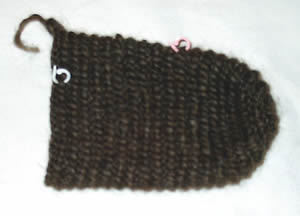 |
 |
| Filling in the after-thought heel | Finished sock with edging |
 |
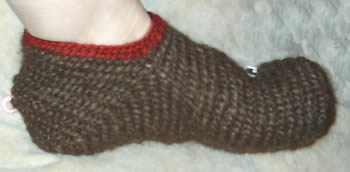 |
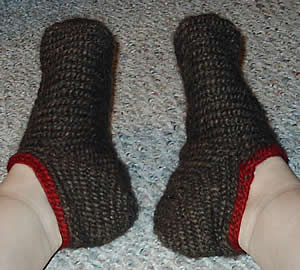 |
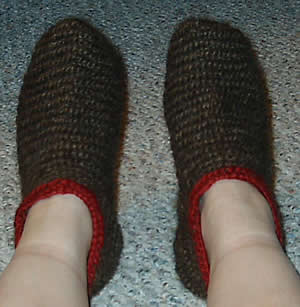 |
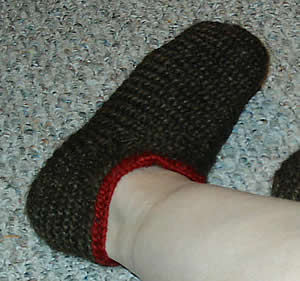 |
Resources:
York Archaeological Trust, Picture Library, Image reference #'s 002246, 003370
Hald, Margrethe. Ancient Danish Textiles from Bogs and Burials. National Museum of Denmark, Copenhagen, 1980. ISBN 87-480-0312-3.
Schmitt, Larry. Lessons in Nålbinding: Lots of Socks. Cottage Grove, Wisconsin: Lawrence W. Schmitt, 2000.
Priest-Dorman, Carolyn. Nålebinding Techniques in the Viking Age. 2001 http://www.cs.vassar.edu/~capriest/nalebind.html
Hutchinson, Elaine. Naalbinding. 2003, Regia Anglorum Publications. http://www.regia.org/naalbind.htm
